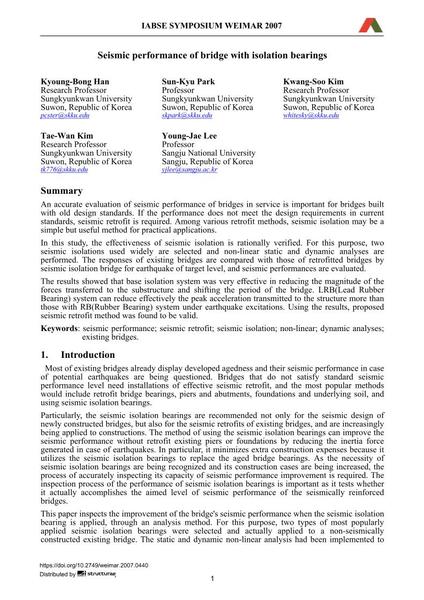Seismic performance of bridge with isolation bearings

|
|
|||||||||||
Détails bibliographiques
| Auteur(s): |
Kyoung-Bong Han
Sun-Kyu Park Kwang-Soo Kim Tae-Wan Kim Young-Jae Lee |
||||
|---|---|---|---|---|---|
| Médium: | papier de conférence | ||||
| Langue(s): | anglais | ||||
| Conférence: | IABSE Symposium: Improving Infrastructure Worldwide, Weimar, Germany, 19-21 September 2007 | ||||
| Publié dans: | IABSE Symposium Weimar 2007 | ||||
|
|||||
| Page(s): | 480-481 | ||||
| Nombre total de pages (du PDF): | 8 | ||||
| Année: | 2007 | ||||
| DOI: | 10.2749/weimar.2007.0440 | ||||
| Abstrait: |
An accurate evaluation of seismic performance of bridges in service is important for bridges built with old design standards. If the performance does not meet the design requirements in current standards, seismic retrofit is required. Among various retrofit methods, seismic isolation may be a simple but useful method for practical applications. In this study, the effectiveness of seismic isolation is rationally verified. For this purpose, two seismic isolations used widely are selected and non-linear static and dynamic analyses are performed. The responses of existing bridges are compared with those of retrofitted bridges by seismic isolation bridge for earthquake of target level, and seismic performances are evaluated. The results showed that base isolation system was very effective in reducing the magnitude of the forces transferred to the substructure and shifting the period of the bridge. LRB(Lead Rubber Bearing) system can reduce effectively the peak acceleration transmitted to the structure more than those with RB(Rubber Bearing) system under earthquake excitations. Using the results, proposed seismic retrofit method was found to be valid. |
||||
| Mots-clé: |
reconception pour effets sismiques
|
||||
